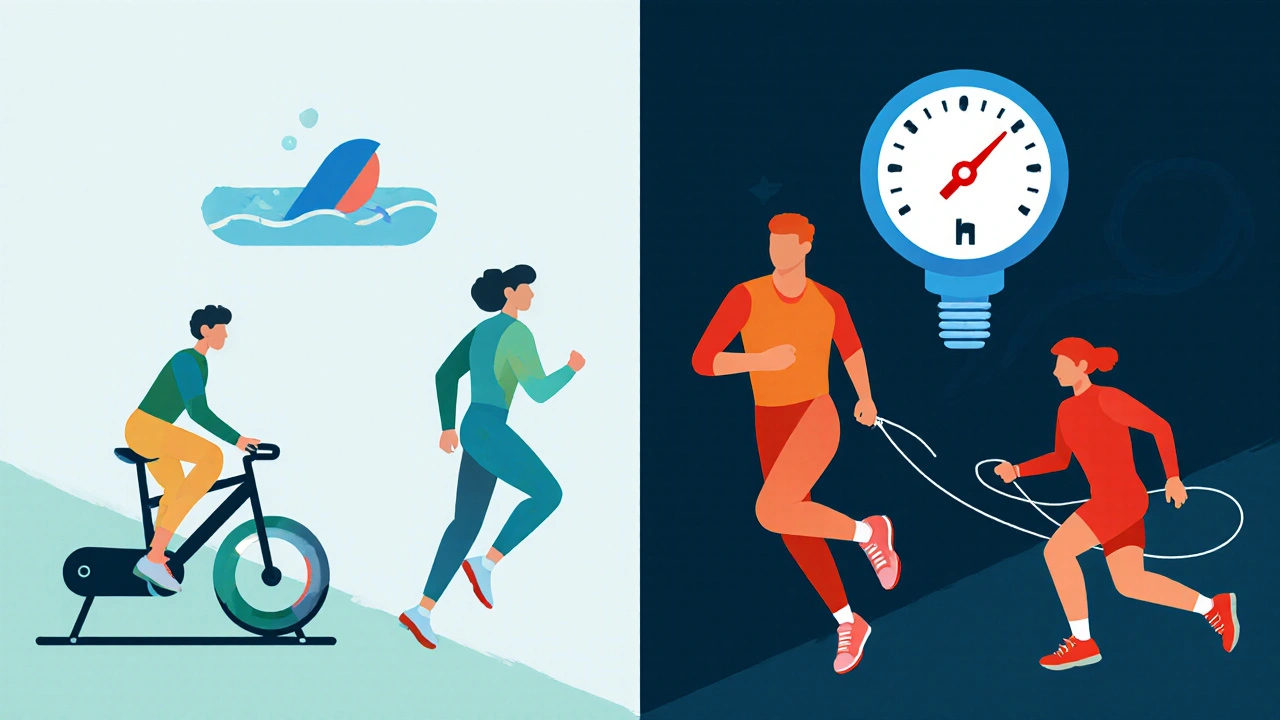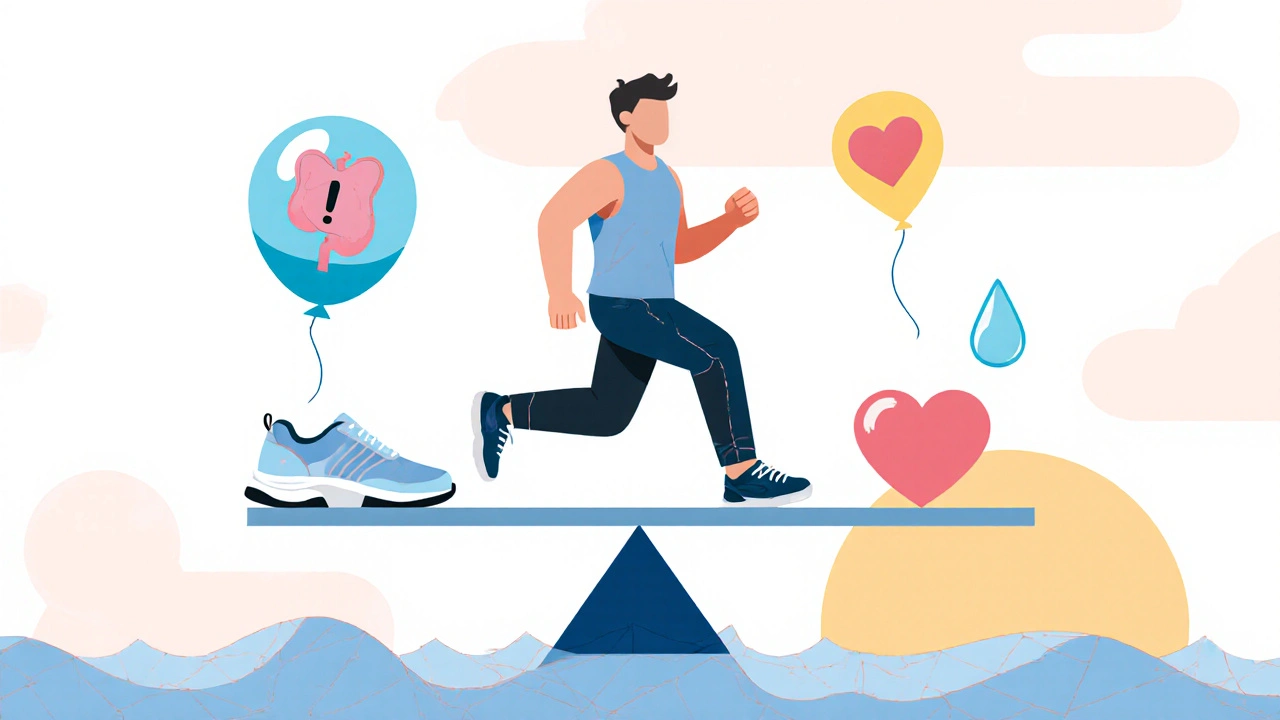Bladder-Friendly Exercise Calculator
Assess Your Exercise Plan
Calculate your bladder impact score based on your chosen activity and habits
Recommended Action
For your activity level, consider adding 2-3 pelvic floor exercises before and after your workout to reduce urgency episodes. Stay hydrated but avoid large fluid intake within 30 minutes of exercise.
Key Tips for Your Routine
- Warm up gradually for 5 minutes before any activity
- Maintain steady breathing to avoid Valsalva maneuver
- Track your bladder urgency in a diary for 2 weeks
Trying to stay fit while dealing with an overactive bladder is a real juggling act. You want the energy boost, stress relief, and heart‑health benefits that exercise brings, but you also dread that sudden urge ringing in the middle of a run. The good news is you don’t have to quit moving altogether. With a few smart choices, you can keep your bladder happy and still get the sweat you need.
What Exactly Is Overactive Bladder?
According to the International Urogynecological Association, Overactive Bladder (OAB) is a symptom syndrome characterized by a sudden, uncontrollable urge to urinate, often accompanied by frequency and nocturia, with or without urge incontinence. It isn’t caused by infection or other underlying disease; it’s a functional problem of the bladder’s muscle and nerve signals.
Why Exercise Can Be a Double‑Edged Sword
Physical activity influences the pelvic region in two major ways. First, it strengthens the muscles that support the bladder, especially the pelvic floor. Second, it can increase intra‑abdominal pressure, which may squeeze the bladder and trigger an urge. The balance depends on the type, intensity, and timing of the workout.
Low‑Impact vs. High‑Impact Workouts
Below is a quick look at how different exercise categories tend to affect OAB symptoms.
| Exercise Type | Typical Activities | Bladder Pressure | Key Benefits | Potential Triggers |
|---|---|---|---|---|
| Low‑Impact | Walking, stationary bike, swimming, yoga | Low | Improves circulation, reduces stress, gentle on pelvic floor | Rare, mostly when fluid intake is high |
| Moderate‑Impact | Elliptical, light jogging, Pilates | Medium | Boosts cardiovascular health, engages core muscles | May provoke urges during hills or intervals |
| High‑Impact | Running, jump rope, HIIT, aerobics classes | High | Strong calorie burn, improves bone density | Sudden spikes in pressure can trigger urgent leaks |
Pelvic Floor Muscle Training (PFMT)
The single most effective non‑pharmacologic tool for OAB is Pelvic Floor Muscle Training (commonly called Kegels). These exercises contract the muscles that form the sling beneath the bladder, giving you better control over the urge.
- Identify the right muscles by stopping urine flow mid‑stream (just for a quick trial, not a regular practice).
- Contract the muscles for 5 seconds, then relax for 5 seconds. Aim for 10 repetitions.
- Do three sets daily - morning, afternoon, and evening.
Research from the Journal of Urology (2023) showed that a 12‑week PFMT program reduced daytime urgency episodes by 30% on average.

Choosing the Right Cardio
If you love cardio, start with low‑impact options:
- Walking: A brisk 30‑minute walk keeps your heart rate in the 100‑120 bpm zone without jarring your pelvic floor.
- Stationary Bike: Adjust the seat so your knees are slightly bent at the bottom of the pedal stroke - this minimizes pressure on the abdomen.
- Swimming: The buoyancy of water supports your body, and the rhythmic breathing helps regulate bladder signals.
Gradually introduce moderate‑impact activities if you feel comfortable, but always monitor how your bladder responds.
Strength and Core Workouts
Core stability exercises that avoid heavy loading on the spine are ideal. Think of moves that engage the transverse abdominis without deep squats or deadlifts.
- Bird‑Dog: On hands and knees, extend opposite arm and leg, hold 5 seconds, switch sides.
- Dead‑Bug: Lie on back, arms toward ceiling, knees at 90°, lower opposite arm and leg, return, repeat.
- Modified Plank: Perform on elbows and knees to keep abdominal pressure low.
These builds support the pelvic floor indirectly, reducing urgency spikes during daily activities.
Fluid Management - Not About Stopping Water
Dehydration can irritate the bladder, while over‑drinking floods it. Aim for 1.5‑2 liters of fluid spread evenly throughout the day. Keep a bladder diary to track when you drink, the type of beverage, and any urgency episodes. Patterns often emerge that help you adjust timing.
Sample Weekly Exercise Plan
Here’s a balanced schedule that blends cardio, PFMT, and core work. Feel free to swap days based on personal preference.
- Monday: 30‑minute brisk walk + PFMT (3 sets)
- Tuesday: 20‑minute swimming + core circuit (bird‑dog, dead‑bug, modified plank, 2 rounds)
- Wednesday: Rest or gentle yoga (focus on breathing)
- Thursday: 30‑minute stationary bike + PFMT
- Friday: Light jogging (5‑minute warm‑up, 15‑minute jog, 5‑minute cool‑down) + core circuit
- Saturday: Stretching + PFMT
- Sunday: Free day - choose an activity you enjoy, but keep an eye on urgency signals.
Notice the progressive increase in impact while still reserving low‑impact days to allow recovery for the pelvic floor.
Common Mistakes to Avoid
- Skipping Warm‑Ups: Jumping straight into high‑impact moves spikes abdominal pressure, increasing the chance of an urge.
- Holding Breath: The Valsalva maneuver (holding breath while exerting) pushes on the bladder. Breathe steadily throughout each rep.
- Over‑Hydrating Right Before Exercise: Drink large amounts within 30 minutes of a workout; you’ll likely need a bathroom break mid‑session.
- Neglecting PFMT: Cardio alone won’t fix OAB; the pelvic floor needs dedicated activation.
When to Call a Specialist
If you notice any of the following, schedule an appointment with a urogynecologist or a continence nurse:
- Urgency episodes more than eight times per day
- Leakage that interferes with daily life despite PFMT and exercise tweaks
- Painful bladder sensations or blood in urine
- Sudden change in symptoms after a new workout routine
Professional assessment can rule out underlying conditions and discuss options like bladder training, medications, or minimally invasive procedures.
Quick Recap
- Choose low‑impact cardio to start; graduate slowly to moderate‑impact if tolerated.
- Do PFMT daily - it’s the cornerstone of bladder control.
- Track fluid intake and urgency with a bladder diary.
- Incorporate core stability moves that keep intra‑abdominal pressure low.
- Consult a specialist if symptoms persist or worsen.
Can running worsen overactive bladder symptoms?
Running is a high‑impact activity that increases pressure on the bladder, so many people notice more urgency during or right after a run. If you love running, try shorter intervals with ample cool‑down time, stay well‑hydrated but avoid large drinks right before, and keep up with pelvic floor exercises to offset the pressure.
Is yoga safe for someone with an overactive bladder?
Yes. Most yoga styles focus on gentle stretching and breathing, which can actually calm bladder nerves. Choose poses that don’t compress the abdomen - avoid deep forward folds right after a big drink and favor seated or supine twists that engage the pelvic floor without high pressure.
How often should I do pelvic floor exercises?
Aim for three sets of ten contractions each day. Consistency is key - the muscles strengthen over weeks, not days. You can integrate the squeezes while brushing teeth, watching TV, or sitting at a desk.
Does caffeine affect overactive bladder during workouts?
Caffeine is a known bladder irritant. If you notice more urgency after your pre‑workout coffee, try switching to a low‑caffeine alternative or limit the amount to one small cup at least two hours before exercising.
Should I wear a protective pad while exercising?
A thin, breathable pad can give peace of mind during high‑impact sessions. Choose a pad designed for active wear to avoid chafing, and remember that it’s a temporary aid while you build pelvic floor strength.


Deja Scott
I appreciate the thorough breakdown of exercise options for those dealing with overactive bladder. The emphasis on low‑impact activities and pelvic floor training feels especially considerate. It’s clear you’ve put thought into balancing fitness and comfort. Walking, swimming, and stationary biking are indeed gentle on the pelvic region while still providing cardiovascular benefits. The inclusion of core stability moves that avoid heavy abdominal pressure is a smart touch. I also like the reminder to monitor fluid intake throughout the day. Keeping a bladder diary can reveal patterns many people overlook. Overall, this guide is a helpful resource for anyone wanting to stay active without aggravating symptoms.